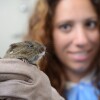Possibly Back From Extinction, Desert Fish Get New Habitat

A tiny Mojave desert fish that was once thought extinct -- and might still be -- is getting a bit more habitat in a small town near Death Valley National Park.
The Shoshone pupfish, a subspecies of desert pupfish that lived in springs along the Amargosa River near the town of Shoshone, was declared extinct in 1970 after repeated surveys failed to find any of the tiny fish. In the mid-1980s, biologists were surprised to find a population of pupfish in a drainage canal that closely resembled the Shoshone pupfish. Those biologists tentatively declared the subspecies "rediscovered" in 1986, though there's a chance that what they found was actually a new population of the closely related Amargosa pupfish.
Whether the pupfish belong to the Shoshone or Amargosa subspecies, their numbers have grown to the point where a few of them have been moved to a publicly accessible pond where tourists can admire them. And much of the credit for their recovery goes to a determined rural landowner.
Best known in the desert for the tiny population in the Devils Hole spring in Nevada, pupfish are a diverse group of tiny, two-inch fish in the genus Cyprinodon. Split into a number of closely related species and subspecies as the larger desert lakes and rivers that made up their Ice Age habitat slowly dried up, pupfish have in many cases found themselves restricted to incredibly small ranges: a spring here, an outflow there. They make do remarkably well considering they're restricted to wet spots in the desert: as long as they have enough water they thrive by eating cyanobacteria, along with occasional small invertebrates.
That "enough water" is the catch. Scarce at the best of times, desert water is increasingly diverted for agriculture, housing, and industrial development. Agriculture and recreation disrupt what surface water remains: fish don't like having their habitat trampled by cows or tires.
That sort of habitat loss was suspected as a cause of the Shoshone pupfish's apparent extinction, but it may well be that things were not as bleak as it had seemed in 1970. The researchers behind that 1986 study figured that earlier surveys had failed to find holdout fish surviving in a patch of reeds near the outflow of the Shoshone Springs. By the time the fish were found, they'd rebounded in numbers and started frequenting more open water near the marsh.
Since then, the fish have thrived under the watchful care of Shoshone's owner, Susan Sorrells, whose work with the pupfish attracted the attention of Robin Flinchum at the Pahrump Valley Times last week. Sorrells, a long-time environmentalist, grew up in the town her great-grandfather had founded and eventually inherited it in 1980. Since then she's worked to keep the town alive, scaring up ways to provide its residents with social services and spearheading the formation of the Amargosa Conservancy.
When the pupfish were rediscovered in 1986, Sorrells worked with the state Department of Fish and Wildlife, the Bureau of Land Management and the Desert Fishes Council to ensure their survival.
Seventy of the rediscovered pupfish were moved to an out-of-the-way spring elsewhere in Shoshone, which Sorrells tended over the years. Now, those seventy pupfish have multiplied into the low four figures. As a result of support from the Desert Fish Habitat Partnership to expand the range of available habitat for the fish there are now four ponds in the area, one of which provides the viewing opportunities mentioned earlier.
Why the uncertainty over whether these are Shoshone or Amargosa pupfish? It has to do with the number of little reinforcing spines -- "rays" -- on the fishes' tail fins.
The Shoshone subspecies, Cyprinodon nevadensis shoshone, was discovered and described by ichthyologist Robert Rush Miller in 1948. (Miller was the scientist who suggested in 1970 that the subspecies had been extinct for a couple years, and a co-author of the 1986 rediscovery paper.) As described in 1948 by Miller, the Shoshone pupfish had 18 rays in their tail fins; the fish found in Shoshone in the 1980s and their descendants living today have just 16. Scientists hypothesize that the difference is a bit of random chance reflecting the population bottleneck the fish went through in the early 1970s, but there still remains a chance that the pupfish in Shoshone aren't Shoshone pupfish but the closely related Cyprinodon nevadensis amargosae, the Amargosa pupfish.
Either way, it's a better end for this population than some of their close relatives had in the next town south: the Tecopa pupfish, found in the outflows of two of Tecopa's hot springs, was declared extinct in 1981 -- and none have been rediscovered since. The difference in Shoshone is a tribute to the effect landowners like Sorrells can have when they decide it's their job to keep the local wildlife thriving.





